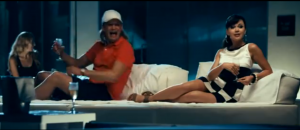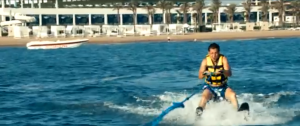Andrew Chapman, Dartmouth College
Sarik Andreasian’s remake Office Romance, Our Time (2011)modernizes El’dar Riazanov’s 1977 plot from the collective Soviet white-collar office space to a cutthroat capitalist Moscow office filled with kompromat and corporate spies. While in Riazanov’s film the madness of romance was offset by the official, rational space of the workplace, Andreasian presents a relationship that is challenged by the greed and deception of the corporate world.
Aside from one major plot twist and divergence at the end of the film, where our two heroes overcome an office scandal, Our Time, also takes one more great liberty in its remake of Riazanov’s classic. The film creates a new space of representation for its characters, and that is the realm of leisure.
In Riazanov’s Office Romance the only respite from work was the romance, which took place on the office rooftop, or the closed doors of Kalugina’s office. Moreover, in Riazanov’s film, any scene that took place out of the work environment was devoted to the family. Novosel’tsev is a devoted single father. Seemingly, any free time for leisure is squeezed out between the responsibilities of middle age at work and at home, partially driving the comedy’s setting for the inappropriate behavior the office romance.
Leisure in Soviet everyday life was cultivated by the state as highly structured activities. It was redefined and systemized through new rituals: holidays, state-sponsored artistic and sport collectivities, and state-run venues such as movie theaters and discos. Free time was encroached on, colonized by state programs (as well as state inefficiency), which tied up people’s schedules and dictated how they should spend their moments away from work. Leisure activities promoted that one’s free time should be spent in the public sphere in a collective atmosphere, rather than the private space of the home.
Riazanov’s film is one of many late Soviet era texts that play with the inversions of leisure time and labor. It is in the forbidden workplace where the romance occurs, interrupting Kalugina’s efficiency to do her job. Riazanov’s later film Forgotten Melody for a Flute (Zabytaia melodiia dlia fleita [1988]) played with this notion of Soviet control over free time, depicting the state’s powerlessness during perestroika. The film’s opening prominently features the fictional bureaucratic institution “The Directorate of Free Time” (Glavnoe upravlenie svobodnogo vremeni), in which directors are discussing that in “these times” almost anything is permissible.
Andreasian’s film changes the constraints of everyday life in a number of ways, depicting a Russian middle class that can work hard and play hard, and still find the time to cultivate family life. For one, Andreasian initiates the office romance not in Moscow, but on a business trip to Turkey, the majority of which is spent at poolside drunken parties and resort cafes.
His unabashed attempts to insert leisure time into the film at times do seem out of place and forced. For instance, there is an extended male-bonding scene between Novosel’tsev and Samokhvalov, where they ride motocross cycles together. The scene stands out, as Novosel’tsev’s comedic awkwardness and diminutive stature gives way to a Russian sportsmen masculinity, in which he races his friend around a dirt track, sailing his bike through the air over multiple jumps, full-clad in riding helmet and body-armor like chest protector pad.
Likewise, the film features another action-sports montage, this time with Novosel’tsev on waterskies, and Kalugina watching and enjoying a drink from the beach.
While these scenes weaken the film, they provide a characterization of the new middle class, whose hobbies include fancy toys and extravagant vacations. Andreasian tries to provide a flashier upgrade to Office Romance,whose characters were modest in comparison to their modern counterparts. What are the class connections between leisure and freedom? Just as in Soviet times, one’s work dictated their access to leisure. Work affords leisure, whether that was a Soviet citizen’s profession, which provided access to the nicer Soviet resort areas, or the Russian Federation citizen’s profession, which provides adequate money to rest in style.[1]
December 2014
[1] See Diane P. Koenker’s article in Slavic Review’s special issue on tourism and travel in Russia and the Soviet Union: “Travel to Work, Travel to Play: On Russian Tourism, Travel and Leisure.” Slavic Review 62.4 (2003): 657-665.





